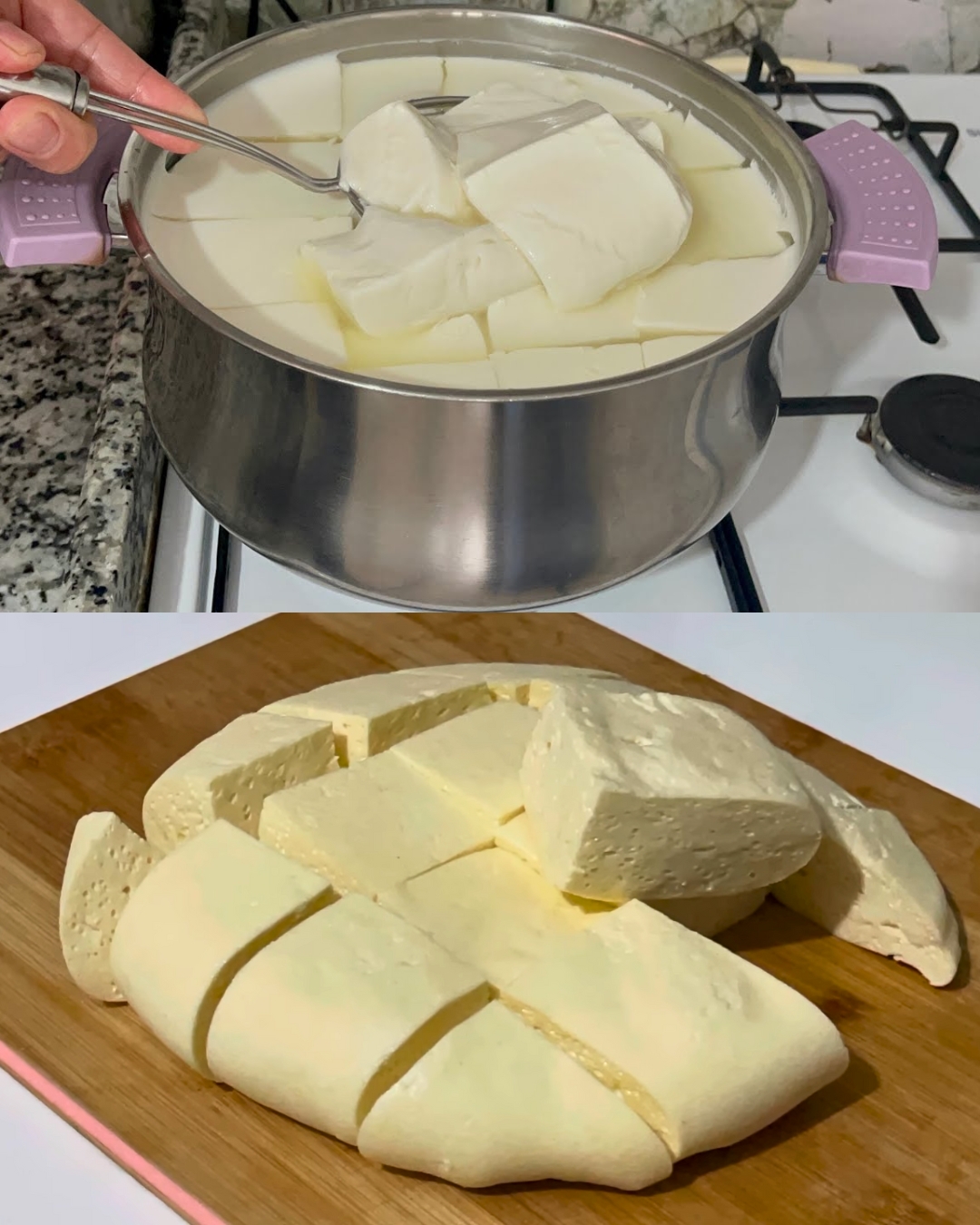Making your own cheese at home might sound intimidating, but this recipe for pickled cheese proves it can be incredibly simple and rewarding. This method focuses on creating a fresh, crumbly cheese that is then preserved in a salty brine, a technique used for centuries to extend the life of dairy products. The resulting cheese is tangy, slightly salty, and has a firm yet delicate texture that is delicious on its own or as part of a larger dish. This recipe requires only a few ingredients and some basic kitchen tools, making it accessible for anyone who wants to try their hand at cheesemaking. It’s a fantastic way to transform fresh, local milk into a unique and flavorful cheese that you can be proud to share with family and friends. This process is not just about making cheese; it’s about connecting with a traditional craft and creating something truly special from scratch.
Full Recipe
Ingredients
- 5 kilos of village milk
- 1 teaspoon of rennet
- Coarse salt for pickling
Cooking Directions
- Warm the milk: Pour the 5 kilos of village milk into a large pot. Place the pot over low to medium heat and gently warm the milk to a temperature of 35-37°C (95-98°F). It’s crucial not to boil the milk, as this will prevent the curds from forming correctly. You can use a thermometer to be precise, or test it with your finger—it should feel warm but not hot.
- Add the rennet: Once the milk is at the correct temperature, remove it from the heat. In a small cup, mix the 1 teaspoon of rennet with a tablespoon of cool water. Stir this mixture into the warmed milk with a slow, gentle, up-and-down motion for about one minute.
- Allow the milk to set: Cover the pot and leave it in a warm place, undisturbed, for approximately 1-2 hours. During this time, the rennet will cause the milk to coagulate and form a solid curd, separating from the yellowish liquid whey. You’ll know it’s ready when the curd has a clean break—if you gently push on the curd, it should split cleanly.
- Cut the curds: Using a long knife, cut the curd into a grid pattern of 1-inch cubes. This step helps release more whey from the curd. Let the curds rest for about 10-15 minutes after cutting.
- Separate the curds and whey: Place a large colander or a fine-mesh sieve over a big bowl. Line the colander with cheesecloth. Gently scoop the curds from the pot and transfer them into the cheesecloth-lined colander. You can save the whey for other uses, like baking or as a nutrient-rich liquid for plants.
- Press the cheese: Gather the corners of the cheesecloth and twist them to form a ball, squeezing out any remaining whey. Place a weight on top of the cheese (like a heavy plate or a bowl filled with water) and let it press for several hours or overnight. This removes more whey and helps the cheese achieve a firm, dense texture.
- Slice and salt the cheese: Once the cheese is firm, unwrap it and slice it into your desired shape and size, typically into blocks or cubes. Generously coat each piece of cheese with coarse salt on all sides. This is the first step in the pickling process, drawing out more moisture and beginning to flavor the cheese.
- Prepare the brine: To pickle the cheese, you’ll need to make a salty brine. A good starting ratio is about 1 cup of coarse salt for every 2 liters of water, but this can be adjusted to your preference. Bring the water to a boil, dissolve the salt, and then let it cool completely to room temperature.
- Pickle the cheese: Place the salted cheese blocks into a large glass jar or a non-reactive container. Pour the cooled brine over the cheese, ensuring it is completely submerged. Seal the container and store it in the refrigerator. The cheese will be ready to eat in a few days, but its flavor will continue to develop over several weeks.
Nutrients
- Calories per serving: (Varies based on milk fat content and serving size)
- Protein: (Varies)
- Fat: (Varies)
- Carbohydrates: (Varies)
- Calcium: (Varies)
- Sodium: (Varies)
Why You’ll Love This Recipe
You’ll love this recipe because it demystifies the art of cheesemaking, transforming it from a complex, daunting task into an accessible and rewarding kitchen project. The simplicity of the ingredients—just milk, rennet, and salt—makes it feel pure and authentic. The process itself is a slow, meditative one that’s deeply satisfying. Watching the milk transform into solid curds and then into a firm block of cheese is truly magical. But the real magic happens in the pickling. This step infuses the cheese with a tangy, salty flavor and a firm texture that is unique and delicious. Unlike many homemade cheeses that must be eaten immediately, this pickled cheese can be stored for an extended period, allowing you to enjoy your creation over time. It’s not just a recipe; it’s a new skill and a delicious connection to a time-honored tradition.
The Origins and Inspiration Behind the Dish
Pickled cheese has a rich history that spans across many cultures, particularly in the Mediterranean, Eastern Europe, and the Middle East. The practice of pickling cheese in a salty brine, or “brining,” was born out of necessity before modern refrigeration. It was the most effective way to preserve fresh cheese, especially during times of abundant milk production. Cheeses like Feta in Greece, Halloumi in Cyprus, and Akkawi in the Middle East all share this brining tradition. The “village milk” mentioned in the recipe is a nod to this rustic, traditional approach, where cheese was made in small batches in rural communities using the freshest milk available. The inspiration behind this specific recipe is to bring that timeless, rustic charm and preservation technique into the modern home kitchen, allowing anyone to experience a taste of history.
Ingredient Spotlight
The success of this simple recipe hinges on the quality and understanding of its few ingredients. Village milk is more than just a name; it refers to fresh, unpasteurized or lightly pasteurized milk, often from a local farm. The less processed the milk, the better, as it contains more of the natural bacteria and enzymes needed for curd formation. Rennet is the star player in this cheesemaking process. It’s a natural enzyme that causes the milk to coagulate and form curds. It’s available in liquid or tablet form and is essential for turning the milk into a solid mass. Finally, coarse salt for pickling is crucial. The larger crystals dissolve more slowly and are ideal for creating a brine that evenly pickles the cheese without making it overly salty on the outside. Using a fine table salt won’t give you the same results, so be sure to get coarse salt.
Storage and Reheating Tips
This pickled cheese is designed for long-term storage. Once it has been brined for a few days, it can be stored in the brine in an airtight container in the refrigerator for several weeks, or even a few months. As it ages, the flavor will become more pronounced and the texture will firm up even more. When you want to eat a piece, simply take it out of the brine, rinse off the excess salt under cool water, and pat it dry. It’s best served at room temperature, as this allows its full flavor to shine. You should not reheat this type of cheese, as its texture is meant to be eaten cold or at room temperature. The brining process ensures the cheese is preserved, so there’s no need to worry about spoilage as long as it remains submerged in the brine.
Common Variations to Try
This recipe provides a fantastic base for creativity. You can easily add herbs or spices to the brine to infuse the cheese with different flavors. For a Mediterranean twist, try adding sprigs of fresh oregano, a few bay leaves, or some peppercorns to the brine. For a spicier version, add red pepper flakes or a whole chili pepper. You can also add flavors to the cheese itself after it’s pressed but before pickling. Mix in some chopped fresh dill, chives, or even a bit of garlic powder. Another variation is to roll the fresh cheese in a mixture of herbs and spices before brining, creating a beautifully flavored crust. You could also experiment with different types of milk, such as goat’s milk or sheep’s milk, which will give the final cheese a distinct and unique flavor profile.
Pairing Recommendations
Pickled cheese is incredibly versatile and pairs well with a variety of foods. Its tangy, salty flavor makes it a wonderful addition to a mezze platter or charcuterie board, alongside olives, cured meats, and fresh vegetables. It’s excellent crumbled over a fresh Greek salad or a salad with fresh tomatoes and cucumbers. It can be served as a simple appetizer with some toasted bread and a drizzle of olive oil. For a more substantial meal, it pairs beautifully with grilled vegetables, roasted potatoes, or as a flavorful component in an omelet. A glass of crisp white wine or a light lager would be a perfect complement to its salty tang.
Advertisement
Health Benefits
While this cheese is pickled in salt, it still offers several health benefits. Milk is a great source of calcium, which is crucial for bone health, and protein, which is essential for muscle repair and satiety. Cheese, in general, is a nutrient-dense food. The pickling process itself can sometimes introduce beneficial bacteria, similar to other fermented foods, though this can vary. By making it at home, you have complete control over the ingredients, allowing you to avoid any additives or preservatives often found in store-bought cheeses. When consumed in moderation as part of a balanced diet, this pickled cheese can be a delicious and wholesome addition to your meals.
Conclusion
In conclusion, making pickled cheese at home is a simple, rewarding, and delicious experience. This recipe, with its minimal ingredients and straightforward process, opens the door to the wonderful world of cheesemaking for everyone. It is a tribute to a timeless preservation technique that produces a unique and flavorful cheese. The joy of creating something from scratch, the satisfaction of watching it transform, and the pleasure of enjoying the finished product are all part of what makes this recipe so special. It’s more than just food; it’s a connection to history, a celebration of simple ingredients, and a delicious new skill. So, go ahead and give it a try—you might just discover your new favorite kitchen hobby.

